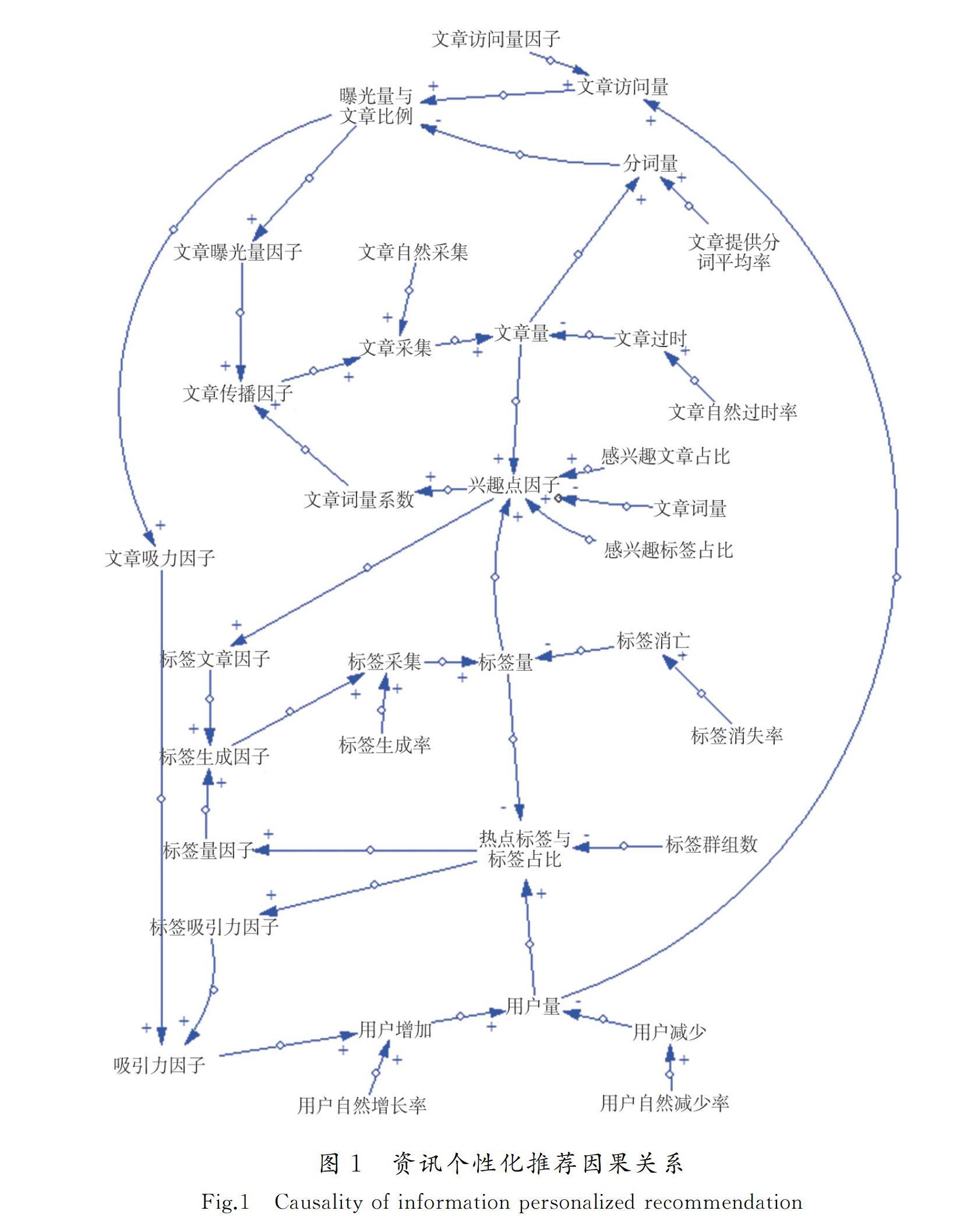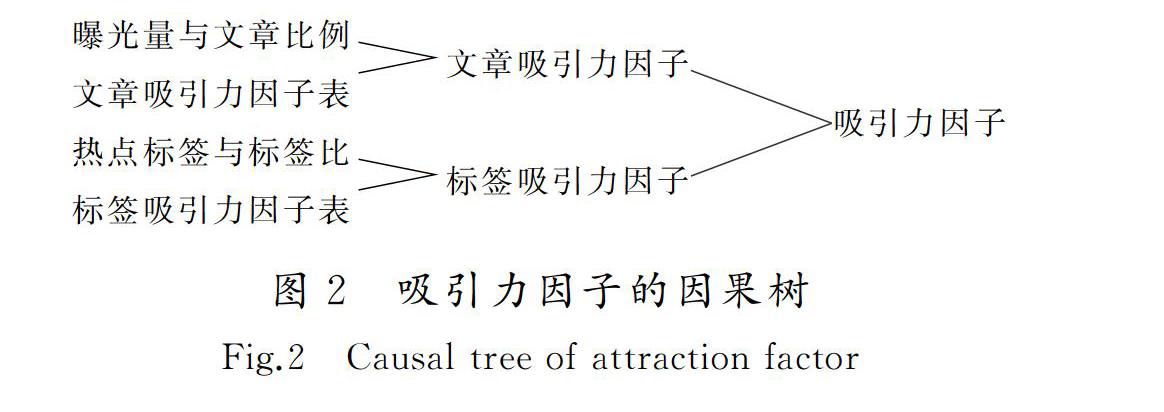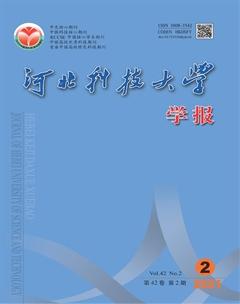基于系统动力学的资讯个性化推荐研究
王子岩 司亮 刘滨 刘宇 孙中贤 刘增杰 张红斌 刘青



摘 要:手机等移动智能终端在全社会的普及,使得数字内容的生产能力下沉到社会各个层面,形成了多源、自主、原生的互联网媒体内容制造格局;而以社交媒体、自媒体为代表的各类新兴媒体的蓬勃发展,使得数字内容的传播能力极大增强,大量衍生内容在敏感、热点、重要事件的报道传播中产生。互联网资讯具有海量、内容质量参差不齐、观点多极等特点。如何将价值导向对正确的、信息披露准确的资讯进行精准推荐,维护和促进社会公平正义,成为司法领域的新问题和新挑战。
推荐系统有效解决了用户在海量信息中难以高效获得信息的问题。基于内容的推荐技术通过分析用户以往感兴趣的项目,经计算得到相似的项目,再将相似度最高的若干项目推送给用户。推荐系统中应用最广泛的是协同过滤推荐算法(collaborative filtering,CF),该概念最早于1992年由GOLDBERG等在开發Tapestry邮件过滤系统时首次提出,其核心思想是运用算法对用户的历史行为数据进行分析,挖掘出用户的兴趣偏好,根据不同的兴趣偏好对用户进行类别划分并推荐相似偏好的物品。当前,个性化推荐已经在电子商务、影视作品、餐饮美食、新闻资讯等领域获得了较为广泛的应用。“京东”的推荐起步于2012年,当时的产品推荐是基于规则匹配进行的,整个推荐产品线组合就像一个个松散的原始部落,部落与部落之间没有任何工程、算法的交集。“淘宝”从2013年推出了“个性化推荐”即“千人千面”的推荐引擎,利用用户的一些行为,通过算法推测出用户可能喜欢的东西。“美团”构建了世界上最大的菜品知识库,为200多万商家、3亿多件商品绘制了知识图谱,并为2.5亿用户画像,构建了世界上用户规模最大的O2O智能推荐平台。“豆瓣”利用社交行为分析解决推荐问题,如基于用户相同行为的协同过滤技术、友邻推荐等,也是个性化推荐的一个补充。社交化推荐的引入,可以解决因单纯产品内容推荐导致推荐范围越来越窄的问题。“今日头条”的个性化推荐算法基于投票方法,其核心理念就是投票,每个用户一票,喜欢哪篇文章就把票投给哪篇文章,经过统计,最后得到的结果很可能是此类人群里最好的文章,并把这篇文章推荐给同类人群用户。该方法看起来似乎很简单,但实际上需要基于对海量用户行为的数据挖掘与分析。
系统动力学是一门基于系统论、控制论与信息论,并借助计算机模拟技术的交叉学科,其通过系统的视角,进行结构化动态分析和模型模拟,擅长分析高阶、非线性时变和复杂系统,采用定性与定量相结合的方法,适合对资讯个性化推荐这种动态复杂过程进行分析。针对司法工作相关资讯的个性化推荐问题,应用系统动力学理论,对影响资讯推荐效果的重要因素在Vensim软件中进行建模仿真,构建包括用户量、文章量、标签数量和各子系统之间影响的因果反馈模型和存量流量模型,建立系统动力学方程模型,经仿真对相关因素进行敏感性分析。结果表明,文章量、设置的特征化标签和对文章的兴趣点因子等都对推荐效果有重要影响,这是在设计推荐系统时需要重点考虑的因素,也是解决推荐系统冷启动、实时性和“信息茧房”等关键问题的重要途径。基于系统动力学进行资讯个性化推荐研究,可以积极有效地应对司法领域资讯披露面临的挑战,提高精准推荐效果。
关键词:数据处理;个性化推荐;司法工作;系统动力学;资讯平台;仿真模拟
中图分类号:TP311.13 文献标识码:A
doi:10.7535/hbkd.2021yx02010
Study on information personalized recommendation
based on system dynamics
WANG Ziyan1,SI Liang2,3,LIU Bin2,3,LIU Yu4,
SUN Zhongxian2,3,LIU Zengjie2,3,ZHANG Hongbin5,LIU Qing2,3
(1.School of Law,Hebei University of Economics and Business,Shijiazhuang,Hebei 050061,China; 2.School of Economics and Management,Hebei University of Science and Technology,Shijiazhuang,Hebei 050018,China; 3.Big Data and Social Computing Research Center,Hebei University of Science and Technology,Shijiazhuang,Hebei 050018,China; 4.Library,Hebei Professional College of Political Science and Law,Shijiazhuang,Hebei 050061,China; 5.School of Information Science and Engineering,Hebei University of Science and Technology,Shijiazhuang,Hebei 050018,China)
Abstract:
With the popularity of mobile intelligent terminals such as mobile phones in the whole society,the production capacity of digital content has sunk to all levels of the society,forming a multi-source,independent and native Internet media content manufacturing pattern.With the vigorous development of various emerging media represented by social media and we media,the propagation ability of digital content has been greatly enhanced,especially in the reporting of sensitive,hot and important events in the process of propagation,which will produce a lot of derivative content.The improvement of the above two abilities causes the internet information to be characterized by mass,uneven content quality and multi-point of view.How to accurately recommend the news of correct value orientation and accurate information disclosure related to judicial work to maintain and promote social fairness and justice has become a new problem and challenge in the judicial field.
Recommender system effectively solved the problem that it was difficult for users to find the information they need efficiently in the mass of information.Content based recommendation technology analyzed the items that users are interested in before,got the similar items by calculation,and then pushed the items with the highest similarity to users.Collaborative filtering (CF) is the most widely used recommendation system,which was first proposed by Goldberg in 1992 when developing tapestry e-mail filtering system.Its core idea is to analyze the user′s historical behavior data through the algorithm,mine the user′s interest preferences,classify users according to different interest preferences,and recommend items with similar preferences.Collaborative filtering is the most widely used algorithm in recommendation system.It was first proposed by Goldberg in 1992 when developing tapestry e-mail filtering system.Its core idea was to analyze the user′s historical behavior data through the algorithm,mine the user′s interest preferences,classify users according to different interest preferences,and recommend items with similar preferences.At present,personalized recommendation has been widely used in e-commerce,film and television works,food and beverage,news and other fields.For example,the recommendation of Jingdong started in 2012,and the recommendation products were based on rule matching.The combination of the whole recommendation product lines was like a loose primitive tribe,and there was no intersection of engineering and algorithm between the tribes.Taobao launched the recommendation engine of "personalized recommendation",namely "thousands of people and thousands of faces" in 2013,which used some users′behaviors to speculate what users may like through algorithms.Meituan has built the world′s largest food knowledge base,created knowledge graphs for more than 2 million businesses and 300 million products,made user portraits for 250 million users,and built the world′s largest O2O intelligent recommendation platform for users. Douban used social behavior analysis to solve recommendation problems,such as collaborative filtering technology based on the sameusers′behavior ,and friends or neighbors recommendation,etc.,which is also a supplement of personalized recommendation.The introduction of social recommendation can solve the problem of narrow recommendation range caused by simple product content recommendation.The personalized recommendation algorithm of Toutiao was based on voting,and its core idea was to vote.Each user can cast his only vote to the article he likes.After statistics,the final result was likely to be the best article in this crowd,and the article would be recommended to the same group of users.This method seems to be very simple,but in fact,it needs massive user behavior data mining and analysis.
System dynamics is an interdisciplinary subject based on system theory,cybernetics and information theory,and with the help of computer simulation technology.From the perspective of system,structured and dynamic analysis and model simulation are conducted,which is good at analyzing high-order,nonlinear and time-varying complex systems,and is suitable for analyzing the dynamic and complex process of personalized information recommendation by combining qualitative and quantitative analysis..Based on the theory of system dynamics,this paper modeled and simulated the important factors that affect the effect of information recommendation in Vensim software,and constructed the causal feedback model and stock flow model including the number of users,articles,tags and the influence among subsystems.The system dynamics equation model was established,and the sensitivity analysis of related factors was carried out.The results show that the number of articles,the characteristic tags and the interest factors of articles all have an important impact on the recommendation effect.They are the key factors to be considered in the design of the recommendation system,and are also the important ways to solve the key problems,such as the cold start,real-time and "information cocoon room" of the recommendation system.Research on information personalized recommendation based on system dynamics can actively and effectively meet the challenges of information disclosure in the judicial field and improve the accurate recommendation effect.
Keywords:
data processing; personalized recommendation; judicial work; system dynamics; information platform;simulation
手机和平板电脑等移动电子设备的普及,让发现、记录和传播身边事、即时事、敏感事的泛计算能力下沉到社会各个层面,促进了各种新兴媒体的产生,互联网大数据从形式到内容都得到了前所未有的发展[1-3];与此同时,习近平总书记提出的让全体人民感受到社会公平正义的要求,也给司法工作提出了新命题。如何在突发公共事件之际通过互联网使司法正能量渗透到社会的方方面面,让司法领域的新闻报道、情况通告成为人民群众乐意读、及时读、愿意传播的信息,成为维护社会稳定、保障国家安全的重要任务,也是当前司法工作面临的挑战性问题[4-6]。资讯个性化推荐技术恰恰能解决对特定主体、特定主题、特定领域互联网内容的推荐问题,能够更敏捷、更高效、更及时地从海量媒体内容中将价值导向正确的、信息披露准确的资讯进行精准推荐,形成良好的社会反响。这种基于内容的推荐技术,通过分析用户以往感兴趣的项目,计算出特征相似的项目,再将相似度最高的若干项目推送给用户。例如:“豆瓣”采用基于协同过滤的个性化新闻推荐系统,可以向用户推荐其可能关注的、特定范围的图片、文字、影像等内容,会对用户浏览过的相关内容进行评价,从而获取到评分信息并进行针对性的推荐;“今日头条”等在呈现新闻信息时同样采用了个性化推荐算法,通过个性化新闻定制设置界面,实现了根据地区、新闻关键字、新闻媒体或者新闻热度等筛选条件,将用户感兴趣的新闻内容呈现出来的效果[7-9]。系统动力学是基于控制论、系统论、信息论、模拟技术等学科,擅长分析高阶、非线性时变、复雜系统的定性与定量分析相结合的工具,也适合分析资讯个性化推荐这种动态复杂的过程[10-12]。
本文应用系统动力学理论,构建资讯平台用户量、文章量、标签量和各子系统之间的因果反馈模型和存量流量模型,建立系统动力学方程模型,并利用Vensim[13-14]对资讯推荐效果的影响因素进行建模仿真和分析。
1 资讯个性化推荐系统重要因素系统动力学识别
1.1 构建资讯个性化推荐系统的因果反馈模型
推荐系统多以定义社会化标签来标注文章特征和用户特征[15-17]。资讯个性化推荐服务主要与用户量、文章量和标签量等相关,因此将行为资讯平台的推荐系统分为3个子系统:1)用户量子系统,包括用户增长量、用户减少量、吸引力等变量;2)文章量子系统,包括文章采集、文章淘汰、文章曝光量、文章上下文分词、文章访问量、文章传播等变量因素;3)联系到用户和文章的标签子系统,包括标签生成、标签消亡、熱点标签、标签群组等变量。以资讯平台用户量的增长为研究目标,构建的资讯个性化推荐因果关系图如图1所示。
1.2 因果反馈模型分析
对在Vensim中构建的因果反馈模型进行分析。系统动力学主要利用反馈机制研究内部结构,从而研究系统的行为模式与特性,建立因果回路,把用户量作为评价资讯平台利用推荐系统效果的主要因素,其中热门标签与标签比、文章访问量等因素正向影响用户量,由此得到4条主要因果反馈回路:
1)用户量→+热点标签与标签比→+标签吸引力因子→+吸引力因子→+用户增加;
2)用户量→+文章访问量→+曝光量与文章比例→+文章吸引力因子→+吸引力因子→+用户增加;
3)用户量→+文章访问量→+曝光量与文章比例→+文章曝光量因子→+文章传播因子→+文章采集→+文章量→+兴趣点因子→+标签文章因子→+标签生成因子→+标签采集→+标签量→+热点标签与标签比→+标签吸引力因子→+吸引力因子→+用户增加;
4)用户量→+热点标签与标签比→+标签量因子→+标签生成因子→+标签采集→+标签量→+兴趣点因子→+文章词量稀疏→+文章传播因子→+文章采集→+文章量→+分词量→-曝光量与文章比例→+文章吸引力因子→+吸引力因子→+用户增加。
由此可知,资讯平台的用户量与文章访问量、热点标签与标签比、文章曝光量因子、文章吸引力因子等形成正反馈回路,通过更高的文章吸引力,带来了更多的文章访问量,提高了文章曝光量;热点标签与标签的比例又反映了文章的实时性等因素,文章的吸引力因子通过用户的兴趣点因子与标签、文章词量的系数等因素相联系,吸引力提高对用户量形成了新的正反馈回路。
不仅如此,还可以直观展示出某一因素的因果树。图2所示为吸引力因子的因果树。
吸引力因子与文章吸引力和标签吸引力有着直接的关系,即在采集新闻资讯平台内容时,需要重点处理用户信息、文章信息和文章上下文这种场景信息,并进行特征分析,提取出用户特征、文章特征和上下文场景特征,便于以后推荐系统根据吸引力情况进行匹配推荐。
2 资讯个性化推荐系统影响因素存量流量模型
2.1 绘制存量流量图
通过对因果关系进行分析与整合,建立完整的资讯个性化推荐系统动力学存量流量模型,如图3所示。
2.2 构建系统动力学方程
2.2.1 建立Vensim方程式
将模型中的变量单位以天(d)为单位,用得到的影响因素指标权重代入系统动力学存量流量模型中,其中涉及到Vensim方程式如下:
兴趣点因子= (感兴趣文章占比*文章量+感兴趣标签占比*标签量)/文章词量;
分词量=文章总量*文章提供分词平均率;
吸引力因子=感兴趣标签占比因子*标签吸引力因子;
文章传播因子=文章词量系数*文章曝光量因子;
感兴趣标签占比因子=感兴趣标签占比因子表(曝光量与文章比例);
文章总量= INTEG(文章采集-文章过时,1 000);
文章曝光量因子=文章曝光量因子表(曝光量与文章比例);
文章访问量=用户*文章访问量因子;
文章过时=文章总量*文章自然过时率;
文章采集=文章总量*文章传播因子*文章自然采集率;
曝光量与文章比例=文章访问量/分词量;
标签吸引力因子=标签吸引力因子表(标签数与活跃标签比例);
标签总量= INTEG(标签采集-标签消亡,18);
标签数与活跃标签比例=用户/(标签群组数*标签总量);
标签文章因子=词量因子表(兴趣点因子);
标签消亡=标签总量*标签消失率;
标签生成因子=标签量因子*标签文章因子;
标签采集=标签总量*标签生成率*标签生成因子;
标签量因子=标签因子表(标签数与活跃标签比例);
用户= INTEG(用户增加-用户减少,500);
用户减少=用户*用户自然减少率;
用户增加=用户*用户自然增长率*吸引力因子;
用户增长率=(用户增加-用户减少)/用户;
文章词量系数=文章词量系数表(兴趣点因子)。
2.2.2 建立表函数
表函数一般用于反映自变量与因变量之间的非线性关系。在Vensim软件中,表函数可以在Lookup选项中把自变量、因变量的最大值和最小值同一些自变量与因变量对应的点值列出,将收集到的关于文章、标签的相关数据用表函数的形式输入到公式中,涉及到的表函数指标如下:
感兴趣标签占比因子表=[(0,0)-(2,2)],(0,2),(0.2,1.95),(0.4,1.8),(0.6,1.6),(0.8,1.35),(1,1),(1.2,0.5),(1.4,0.3),(1.6,0.2),(1.8,0.15),(2,0.1);
文章曝光量因子表=[(0,0)-(2,2)],(0,0.2),(0.2,0.25),(0.4,0.35),(0.6,0.5),(0.8,0.7),(1,1),(1.2,1.35),(1.4,1.6),(1.6,1.8),(1.8,1.95),(2,2);
文章词量系数表=[(0,0)-(1,2)],(0,1),(0.1,1.15),(0.2,1.3),(0.3,1.4),(0.4,1.45),(0.5,1.4),(0.6,1.3),(0.7,0.9),(0.8,0.5),(0.9,0.25),(1,0);
标签吸引力因子表=[(0,0)-(2,2)],(0,1.4),(0.2,1.4),(0.4,1.35),(0.6,1.3),(0.8,1.15),(1,1),(1.2,0.8),(1.4,0.65),(1.6,0.5),(1.8,0.45),(2,0.4);
标签因子表=[(0,0)-(2,2)],(0,0.2),(0.2,0.25),(0.4,0.35),(0.6,0.5),(0.8,0.7),(1,1),(1.2,1.35),(1.4,1.6),(1.6,1.8),(1.8,1.95),(2,2);
词量因子表=[(0,0)-(1,2)],(0,0.4),(0.1,0.7),(0.2,1),(0.3,1.25),(0.4,1.45),(0.5,1.5),(0.6,1.5),(0.7,1.4),(0.8,1),(0.9,0.5),(1,0)。
2.2.3 确定影响因素的初始值
本文主要研究资讯个性化推荐的主要影响因素和机制,注重关键因素对整体资讯平台的影响,因此,初始值设置的精确性不会对结论产生影响。为了便于研究,模型中变量因素的初始值根据实际项目经验设置,如表1所示。
将以上方程、表函数指标以及变量因素初始值代入Vensim存量流量模型中,对模型进行仿真检验。
2.3 模型检验
第1步,需要对系统的边界进行检验,通过观察模型中增加或者减少变量是否能够形成闭合回路来验证该变量是否对所研究的问题产生影响。验证无误后进行第2步运行检验,使用Vensim中model菜单下的“Check Model”功能,对模型中所有的变量进行检验。检验显示,所有变量已经赋值,且各变量之间均已建立了系统动力学方程。
3 系统动力学仿真分析
3.1 因素模拟分析
在Vensim软件中,对资讯个性化推荐系统动力学存量流量模型进行仿真模拟分析,在保持原始设定参数不变的情况下,关键影响因素中用户量、文章量与标签量的变化趋势如图4所示。
在图4中,用户量、文章量、标签量存在明显正相关关系,这3个量都是存量,是一个累计值,从趋势上看,都是随着时间的变化先增加后减少,并且在模型运行初期都有明显加速的过程,在模拟到30 d左右达到峰值,之后虽然推荐系统也在不断工作,但是在没有外因进行刺激的情况下,资讯平台的用户量开始呈下降趋势。其余因素的变化,亦可通过仿真分析变化趋势,由于篇幅所限,在此不再赘述。
3.2 变动参数的仿真结果分析
在进行仿真分析时,研究各变量对整体系统的影响,往往采取调节某一变量的值来观察其对系统的具体影响。资讯平台个性化推荐系统设计时,常常需要对用户以及文章情况打上特征标签,其中标签群组数代表定义用户标签的个数,图5所示代表了分别给一个用户打上5个、3个和7个的标签时,最终对吸引力因子和用户量的影响。由图5可知,在合理范围内,更明确的特征标签数能够对用户量产生更为积极的影响。
在推荐系统中,普遍存在稀疏性问题,即在系统运行初期,由于用户和文章的特征较少,所以导致推荐效果较差。因此在对文章内容上下文场景进行分析时,文章内容的长短影响着阅读体验,同时,系统对文章的切词和分词进行语义处理,也影响着数据的稀疏性问题。以文章3 000字数为基准,测试字数对吸引力因子和用户量的影响,如图6所示。由图6可知,在合理范围内,文章字数的变化对吸引力因子和用户量的影响不大,解决稀疏性问题可通过用户或文章聚类以及增加对内页的优化,增加转发与点赞、打分等手段,增加用户对平台的互动性,收集用户和文章的特征信息,在一定程度上可解决稀疏性问题。
4 结 语
1)文章量、特征化标签和文章兴趣点因子等都对推荐效果有重要影响,同时也存在边际递减效应。冷启动[18]、实时性[19]、稀疏性和“信息茧房”[20]等问题是每个推荐系统的共性问题。
2)对平台既有用户,利用其注册信息打上用户标签,对资讯也打上语义分类标签,可缓解冷启动问题;被推荐的资讯最好有一定的时效,可加入被关联的热点内容,提高文章的吸引力與可读性,提高推荐系统的实时性,破解“信息茧房”问题。
3)对司法工作领域的资讯个性化推荐而言,首先,较高的新闻数量和曝光量有助于资讯平台引流和提升黏性,但是要避免“信息过载”[21]导致的用户体验差乃至“脱粉”(取消平台关注)等问题,所以,需要平衡推荐新闻的量和种类;其次,要重视上线后首批用户的使用体验,从敏感性分析来看,如果带给首批用户更好的体验,将会带来良好的用户增长曲线。
4)如果仅在司法新闻资讯个性化推荐这一点上发力,由于用户兴趣点衰退等原因,其平台自身发展往往会落入瓶颈期,用户量难以持续增长。所以,本研究未来工作将结合资讯平台具体的运营情况,在不断完善推荐系统的同时,丰富平台功能,增加客户与应用平台的互动性,挖掘和分析用户增长曲线和用户黏性的变化规律。
参考文献/References:
SUN Z,DAN C L,SHI Y.Big data analysis on social networking//IEEE International Conference on Big Data (Big Data)[C].Los Angeles:IEEE,2019:6220-6222.
[2] RUBEN T,JORDI T,EDUARD A.Multimedia big data computing for in-depth event analysis[C]//IEEE International Conference on Multimedia Big Data.Beijing:IEEE,2015:144-147.
[3] FENG C,KHAN M,ARIF U R,et al.News recommendation systems:Accomplishments,challenges & future directions[J].IEEE Access,2020,8:16702-16725.
[4] 李明,刘滨.基于数据驱动的司法公开信息化监管系统[J].河北科技大学学报,2016,37(4):407-415.
LI Ming,LIU Bin.Data driven information system for supervision of judicial open[J].Journal of Hebei University of Science and Technology,2016,37(4):407-415.
[5] 邓凯.试论中国司法信息化的演进及其技术路径[J].决策探索,2021(1):49-53.
DENG Kai.Research on the evolution of China's judicial informatization and its technical path[J].Policy Research & Exploration,2021(1):49-53.
[6] 孙笑侠.论司法信息化的人文“止境”[J].法学评论,2021,39(1):22-37.
SUN Xiaoxia.Research on the humanity edge of judicial informatization[J].Law Review,2021,39(1):22-37.
[7] XIE Jin,ZHU Fuxi,LI Xuefei,et al.Attentive preference personalized recommendation with sentence-level explanations[J].Neurocomputing,2021,426:235-247.
[8] LI Hui,LI Haining,ZHANG Shu,et al.Intelligent learning system based on personalized recommendation technology[J].Neural Computing and Applications,2019,31(9):4455-4462.
[9] LI M,WANG L.A survey on personalized news recommendation technology[J].IEEE Access,2019,7:145861-145879.
[10]刘扬.利用系统动力学理论探究大数据监管作用机理[J].信息通信技术与政策,2019(10):76-81.
LIU Yang.Using system dynamics to analyze the mechanism of big data regulation[J].Information and Communications Technology and Policy,2019(10):76-81.
[11]李洪波,熊励,刘寅斌.基于系统动力学的信息管理研究:框架与综述[J].情报科学,2017,35(2):164-170.
LI Hongbo,XIONG Li,LIU Yinbin.Information management research based on system dynamics:A framework and literature review[J].Information Science,2017,35(2):164-170.
[12]叶琼元,夏一雪,张鹏,等.面向舆情大数据的突发事件民意系统演化机理与仿真研究[J].情报科学,2019,37(1):80-85.
YE Qiongyuan,XIA Yixue,ZHANG Peng,et al.The evolution mechanism and simulation of internet public opinion for emergent [J].Information Science,2019,37(1):80-85.
[13].System dynamics approach for analyzing internet rumor model using Vensim[J].Journal of Cybercommunication Academic Society,2013,30(3):79-113.
[14]徐建全,楊沿平.基于Vensim的汽车轻量化全生命周期动态评价[J].计算机集成制造系统,2020,26(4):954-969.
XU Jianquan,YANG Yanping.Dynamic evaluation of lightweight automobile life cycle based on Vensim software [J].Computer Integrated Manufacturing Systems,2020,26(4):954-969.
[15]AN S,ZHAO Z,ZHOU H.Research on an agent-based intelligent social tagging recommendation system[C]//9th International Conference on Intelligent Human-Machine Systems and Cybernetics (IHMSC).Hangzhou:[s.n.],2017:43-46.
[16]XU Z,TIFREA-MARCIUSKA O,LUKASIEWICZ T,et al.Lightweight tag-aware personalized recommendation on the social web using ontological similarity[J].IEEE Access,2018,6:35590-35610.
[17]ZHANG J,YANG Y,ZHUO L,et al.Personalized recommendation of social images by constructing a user interest tree with deep features and tag trees[J].IEEE Transactions on Multimedia,2019,21(11):2762-2775.
[18]WANG Xinghua,PENG Zhaohui,WANG Senzhang,et al.CDLFM:Cross-domain recommendation for cold-start users via latent feature mapping[J].Knowledge and Information Systems,2020,62:1723-1750.
[19]王智圣,李琪,汪靜,等.基于隐式用户反馈数据流的实时个性化推荐[J].计算机学报,2016,39(1):52-64.
WANG Zhisheng,LI Qi,WANG Jing,et al.Real-time personalized recommendation based on implicit user feedback data stream[J].Chinese Journal of Computers,2016,39(1):52-64.
[20]王瑞.“信息茧房”的实质、成因与突围之道[J].青年记者,2020(36):23-24.
[21]周万珍,曹迪,许云峰,等.推荐系统研究综述[J].河北科技大学学报,2020,41(1):76-87.
ZHOU Wanzhen,CAO Di,XU Yunfeng,et al.A survey of recommendation systems[J].Journal of Hebei University of Science and Technology,2020,41(1):76-87.

